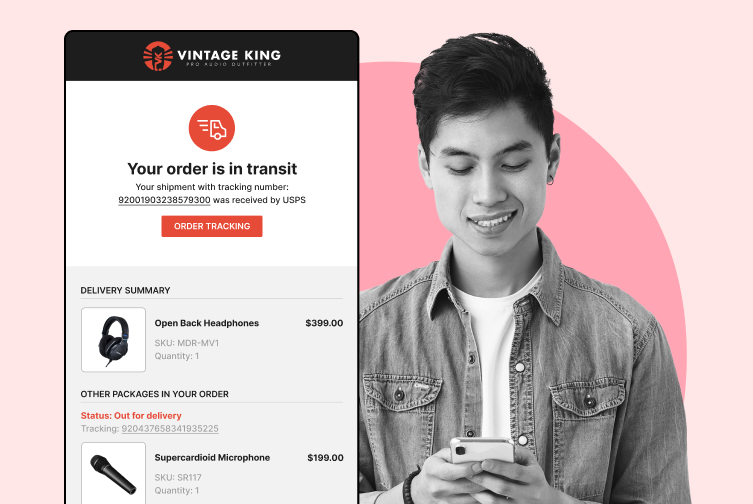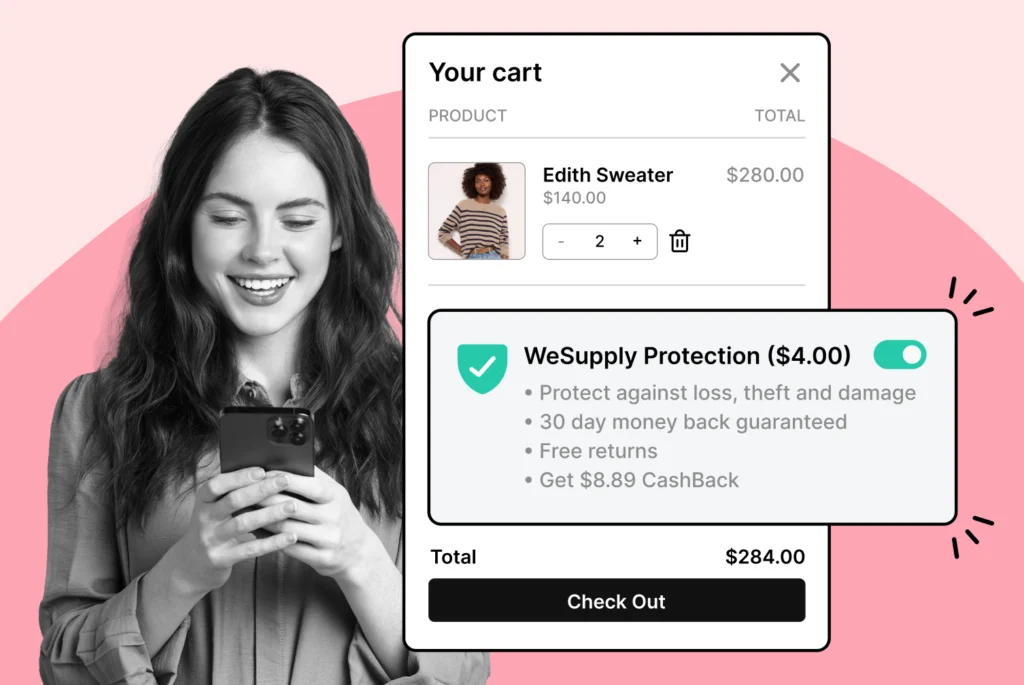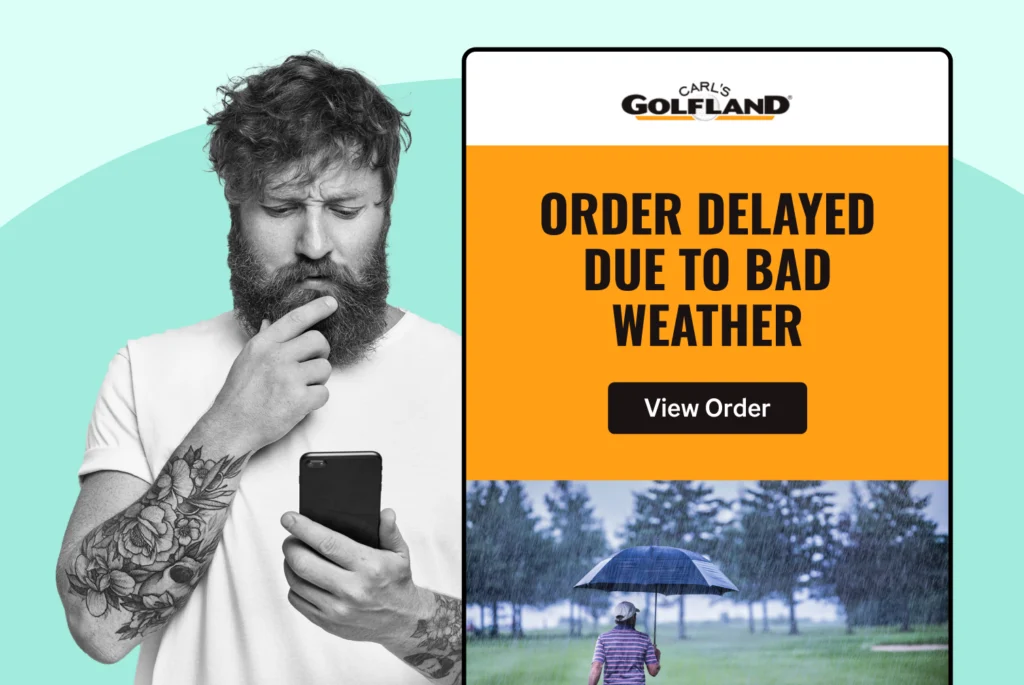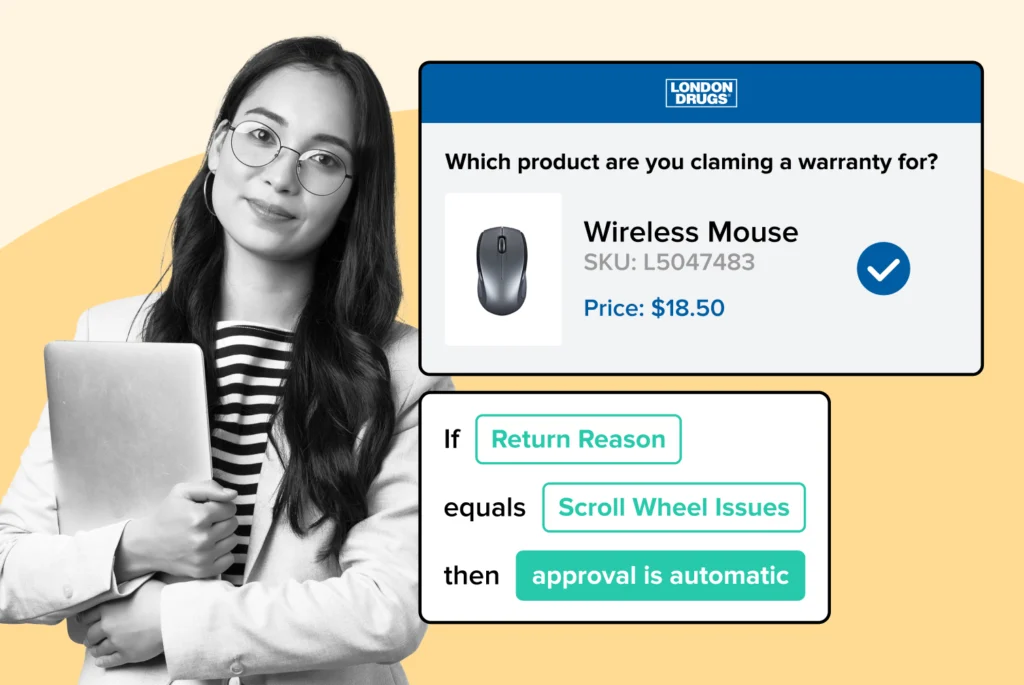
How to Manage Split Shipments Without Confusing Your Customers
Discover effective strategies to manage split shipments, reduce delays, and enhance customer satisfaction. Practical solutions!
Shipping, Tracking & Notifications
Boost customer experience and reduce support tickets
Realtime order and shipment tracking
Proactive order and shipping notifications
AI-Enhanced Discounted Labels
Predictive pre-purchase estimated delivery dates
Self-Serivce branded order tracking
Effortless experience delivered
Identify and Resolve Order Issues
Realtime order and shipment tracking
Make returns profitable and delight customers
Flexibility to define any return destinations & conditions
Simplify returns for your customers and team
Incentivize exchanges over returns
Returns management made easy for your team
Returns management made easy for your team
Easy claims and smart upsells
Understand why your customers are returning
In-Store & Curbside Pickup
Unify the online and the in-store experience
Hassle-free pickup experience for customers
In-Store dashboard to keep operations streamlined
In-Store and Online orders unified
Drive foot-traffic to your stores
Shipping, Tracking & Notifications
Boost customer experience and reduce support tickets
Realtime order and shipment tracking
Proactive order and shipping notifications
AI-Enhanced Discounted Labels
Predictive pre-purchase estimated delivery dates
Self-Serivce branded order tracking
Effortless experience delivered
Identify and Resolve Order Issues
Realtime order and shipment tracking
Make returns profitable and delight customers
Flexibility to define any return destinations & conditions
Simplify returns for your customers and team
Incentivize exchanges over returns
Returns management made easy for your team
Returns management made easy for your team
Understand why your customers are returning
In-Store & Curbside Pickup
Unify the online and the in-store experience
Hassle-free pickup experience for customers
In-Store Dashboard to keep operations streamlined
In-Store and Online orders unified
Drive foot-traffic to your stores
Boost customer experience and reduce support tickets
Realtime order and shipment tracking
Proactive order and shipping notifications
AI-Enhanced Discounted Labels
Predictive pre-purchase estimated delivery dates
Self-Serivce branded order tracking
Effortless experience delivered
Make returns profitable and delight customers
Flexibility to define any return destinations & conditions
Simplify returns for your customers and team
Incentivize exchanges over returns
Returns management made easy for your team
Equip your team for precise return checks.
Easy claims and smart upsells
Understand why your customers are returning
Unify the online and the in-store experience
Hassle-free pickup experience for customers
In-Store Dashboard to keep operations streamlined
In-Store and Online orders unified
Drive foot-traffic to your stores
Find the answer to all your questions
Take a step by step trip through our functionality to see how we can improve your ecommerce processes.
Explore the most comon questions about WeSupply
Calculate the ROI that WeSupply can bring you
Request a no strings attached review of your current shopping experience and missed conversion opportunities
Read actionable articles on how to optimize your post-purchase experience and decrease support tickets
Get inspired by stories of how our customers implemented an effortless post-purchase experience
Wondering if WeSupply is a good fit for you? Read through our use cases to see how we can help you increase conversion & improve CX!
A Deep Dive into Top Companies' Order Tracking & Returns Strategy
Find the answer to all your questions
Explore the most comon questions about WeSupply
Calculate the ROI that WeSupply can bring you
Request a no strings attached review of your current shopping experience and missed conversion opportunities
Take a step by step trip through our functionality to see how we can improve your ecommerce processes.
Read actionable articles on how to optimize your post-purchase experience and decrease support tickets
Get inspired by stories of how our customers implemented an effortless post-purchase experience
A Deep Dive into Top Companies' Order Tracking & Returns Strategy
Wondering if WeSupply is a good fit for you? Read through our use cases to see how we can help you increase conversion & improve CX!

In ecommerce, trust is everything and nothing tests that trust more than a shipping delay. In a digital age where customers expect lightning-fast fulfillment and real-time updates, even the smallest disruption can cause dissatisfaction. But here’s the good news: customers don’t necessarily abandon a brand because of a delay. They leave because they feel ignored, confused, or misled.
That’s why proactively communicating shipping delays is no longer optional—it’s a critical component of customer experience. Meeting customer expectations requires a proactive approach, ensuring customers are informed before they have to ask. When communicating delays, it’s also essential to express empathy, acknowledging customer frustrations and showing understanding. This guide walks you through every step, from preparing internally to managing post-delivery feedback. With the right approach, shipping delays can be transformed from a point of friction into an opportunity to show transparency, empathy, and commitment to service.
Shipping delays are often the result of multiple variables some within your control and others not. These include:
Supply chain issues and supply chain risks, such as production bottlenecks, shortages of raw materials, and inventory shortages, which can disrupt schedules and delay shipments.
Carrier capacity constraints, where limited transportation capacity or logistical hurdles impact the timely delivery of goods.
Labor shortages, which can cause significant disruptions in shipping operations and lead to delays in customer service.
Operational issues, including incorrect address details, inaccurate addresses, customs holdups, or incomplete documentation.
Global events, such as geopolitical crises or natural disasters, can cause significant disruptions that delay shipments.
Economic and political instability, which can slow down global shipping lanes.
Understanding these causes not only helps internal teams plan better but also provides a foundation for clear, transparent communication with customers.
Shipping delays don’t just frustrate customers, they can ripple through your entire operation. Unmanaged, they result in:
Negative reviews or customer churn
Strained partnerships with vendors and carriers
Inventory mismanagement (either overstock or stockouts)
Increased customer support tickets, raising operational costs
Reduced profit margins and increased or extra costs due to higher shipping fees, holding costs, and expedited shipping expenses
Delays can also damage customer relationships by eroding trust and satisfaction, and harm business relationships if communication is not handled transparently and empathetically.
The key to mitigating these outcomes? Communicate early, honestly, and often.
Before you can communicate effectively with customers, you need a solid grasp of what’s happening behind the scenes. Implementing real-time tracking tools that monitor shipments at every stage gives your team visibility and helps identify potential issues early. Incorporating order tracking allows for real-time monitoring of delivery status, enabling proactive updates and transparency for customers.
Just as important is internal alignment. Your customer support, logistics, and marketing teams need to work from the same playbook. When a delay occurs, everyone should know what’s happening, why it’s happening, and how it will be communicated, which strengthens the business’s ability to respond effectively to disruptions.
Don’t wait until a crisis hits to draft a response. Prepare communication templates for different scenarios, carrier delays, weather disruptions, warehouse shortages, etc. with fill-in-the-blank fields for order numbers, customer names, and estimated delivery dates. Automating repetitive tasks like sending these updates can save time and improve consistency across your customer service communications. This ensures your team can respond swiftly without scrambling.
The moment a delay is confirmed, reach out before the customer does. Whether it is an unexpected delay or even a slight delay, promptly notifying customers is crucial to maintain transparency and trust. Silence can be perceived as neglect or disorganization. A proactive message—even if the situation is still unfolding—shows that your brand is responsible and trustworthy.
Your messaging should be clear, concise, and free of blame-shifting or vague language. For example:
“Due to severe weather affecting our carrier network, your order is now expected to arrive by July 15 instead of July 12. We sincerely apologize for the inconvenience and are working to expedite your shipment. Your new estimated delivery date is July 15.”
Clarity helps manage expectations. Vague updates like “Your order is delayed” can cause confusion and lead to follow-up complaints or support tickets.
Email is ideal for delivering detailed explanations. It gives you room to apologize, explain, and offer solutions. Personalize the message with the customer’s name, include the order number and tracking link, and outline the cause of the delay. If applicable, add information on what you’re doing to resolve the issue and any goodwill gestures. Be sure to offer further assistance by inviting the customer to reply to the email or contact your support team if they have any additional questions or concerns.
Marketing automation tools like Omnisend make this process seamless by enabling triggered delay workflows based on shipping status.
SMS has an open rate of over 90%, making it perfect for urgent updates. However, use it with caution—only if you have consent. Keep the message short and direct, and always follow up with a more detailed email.
Example:
“Hi Anna, your Order #4551 is delayed due to carrier issues. New ETA: July 15. More details in your email. Thank you for your patience!”
If you’re dealing with a widespread issue (e.g., port congestion or a weather event), place a notice on your website or a dedicated order status page. This preemptively answers customer questions and reduces incoming support tickets.
Your brand’s social media pages are great for posting general updates about delivery disruptions. But never share order-specific information in public comments direct users to DMs or support channels instead.
When delays happen, customers often just want to know that you care. Use human language, not legalese or generic phrases.
Here’s a better way to phrase it:
“We know how frustrating it can be when an order doesn’t arrive on time especially when you’re excited about receiving it. We’re truly sorry for the delay and are doing everything we can to get it to you quickly.”
Empathy turns a problem into a shared moment of understanding. It shows that you value their time and trust.
Offering a small gesture of appreciation goes a long way in turning a potentially negative experience into a positive one.
Consider options like:
A 10–20% discount code for the next purchase
Free shipping on a future order
An apology credit (“Here’s $10 off your next order”)
Free expedited shipping once the item is back in stock
The option to cancel the order and receive a full refund
High-value customers or subscribers may also appreciate a personal phone call or handwritten note, which reinforces loyalty. Small business owners can further personalize compensation strategies to fit their unique customer relationships and business needs.
Once the initial delay message has been sent, keep the customer informed until the package arrives. Even if there’s no major change, a quick update reassures them that you’re still monitoring their order.
You can set up automated workflows that send emails or SMS messages every 48–72 hours with:
The current order status
The expected delivery window
A direct link to live tracking
Contact options for further questions
After the order is delivered, send a thank-you email that:
Acknowledges the delay again
Thanks the customer for their patience
Offers a small loyalty bonus if appropriate
Invites feedback via a survey or star rating
This not only reinforces your commitment to service but also gives you valuable insight into what’s working and what’s not.
Your support team is the voice of your brand during a crisis. Invest in training programs that focus on:
De-escalation tactics
Tone-of-voice guidelines
Compassionate language
Flexible decision-making (e.g., when to offer a refund)
Also, empower them with tools that provide real-time order insights, canned responses, and permission to resolve issues without managerial approval.
Automation tools like Zendesk, Gorgias, or Re:amaze can help handle repetitive delay queries and improve response times.
Communicating shipping times accurately starts at the point of purchase. Use real-time delivery estimates powered by carriers or tools like WeSupply to set clear expectations before the customer completes their order.
Include disclaimers about peak-season delays or shipping cut-off dates, and reinforce that in order confirmation emails.
If delays occur after purchase, update customers regularly using branded tracking pages and confirmation emails that keep them informed without needing to contact support.
Delays during high-demand periods like holidays or sales events—are common. The difference lies in how prepared you are.
Use historical data to forecast order volume spikes
Set up prewritten delay templates and banner messaging
Update your FAQ page with expected shipping timelines
Schedule updates and marketing campaigns that set realistic expectations
Platforms like Omnisend offer holiday marketing calendars and automation tools to help you stay ahead.
Automation allows you to scale communications without sacrificing personalization. Tools like:
WeSupply: Offers delivery notifications, return portals, and accurate EDDs
Wonderment: Automates delivery status emails and offers branded tracking pages
Omnisend: Sends targeted SMS/email campaigns based on shipping triggers
Easyship: Provides real-time carrier data, shipping label automation, and customs forms
These integrations ensure that customers stay informed, even as your volume grows.
After each major shipping disruption, conduct an internal review:
What caused the delay?
Was communication timely and effective?
What feedback did customers share?
How did support teams respond?
Use surveys to gather data directly from affected customers. Include open-ended questions like:
“How would you rate our communication during the shipping delay?”
“What could we have done better?”
Apply what you learn to improve your next delay response and adjust your playbooks accordingly.
Extreme weather events such as hurricanes, floods, and blizzards can wreak havoc on shipping operations, causing significant shipping delays and widespread disruptions throughout the supply chain. When severe weather strikes, it can damage infrastructure, block key shipping routes, and halt production schedules, impacting the entire supply chain from manufacturing to final delivery. These disruptions often lead to delivery delays that are beyond the control of even the most efficient supply chain managers.
In fact, only a quarter of businesses feel fully prepared to handle the impact of extreme weather on their supply chain. This uncertainty makes it even more critical for supply chain managers to work closely with shipping partners and the customer support team to monitor conditions and respond quickly. By keeping a close eye on weather forecasts and maintaining open lines of communication, businesses can better anticipate potential delivery delays and keep customers informed about changes to delivery times. Proactive coordination across the entire supply chain ensures that everyone—from logistics teams to customer support—can provide accurate, timely updates and minimize the impact of extreme weather on customer satisfaction.
When it comes to weather-related shipping delays, preparation and transparent communication are your best defenses against customer dissatisfaction. Start by developing a robust contingency plan that outlines how your business will respond to natural disasters and other unexpected events. This plan should include clear protocols for updating customers, offering alternative solutions, and providing up-to-date information on the status of delayed shipments.
Transparent communication is key, use email communications, phone calls, and online updates to keep customers informed about shipping delays as soon as they arise. Let customers know what’s happening, why it’s happening, and what steps you’re taking to minimize disruptions. If possible, offer expedited shipping options or alternative delivery methods to ensure timely delivery once conditions improve. By proactively reaching out and providing honest, up-to-date information, you can demonstrate your commitment to customer loyalty and show that you’re doing everything possible to handle delivery delays caused by natural disasters.
Ultimately, customers appreciate being kept in the loop, especially during unexpected events. By offering alternative solutions and maintaining open, transparent communication, you can minimize disruptions, reduce customer dissatisfaction, and strengthen trust even when the weather is out of your control.
Eliminate shipping anxiety
Book a quick call with our experts to see how WeSupply can help you fulfill customer demands and gain long-term trust by clearly addressing order arrival times and keeping them.
In today’s fast-paced ecommerce landscape, shipping delays are inevitable but how you communicate them makes all the difference. That’s where WeSupply steps in. Our platform empowers you to take control of your post-purchase experience with real-time visibility, proactive alerts, and personalized updates keeping customers informed and satisfied every step of the way.
With WeSupply, you can:
✅ Spot delayed and stalled shipments instantly – Get ahead of potential issues by identifying problems early and communicating with customers before they reach out.
✅ Send proactive order and shipping notifications – Automatically notify customers of delays, exceptions, or warehouse issues, reducing WISMO tickets and building trust.
✅ Track orders across 1000+ carriers in real time – Whether it’s Parcel, LTL, or same-day delivery, we give you full visibility from first scan to final delivery.
✅ Support multi-shipment orders seamlessly – Let customers know exactly what’s arriving and when, even if their order is split across multiple boxes.
✅ Deliver branded, engaging updates – Customize every notification to match your look and voice, turning alerts into brand-building moments.
✅ Enable omnichannel tracking – Unify tracking across web, app, POS, marketplaces, and more, so customers always have one place to check their order status.
✅ Drive loyalty with upsell-ready tracking pages – Add product recommendations, collect feedback, and turn delays into new revenue opportunities.
By proactively addressing shipping delays with WeSupply, you won’t just prevent complaints, you’ll create a seamless, reassuring post-purchase experience that keeps customers coming back.
Ready to turn shipping delays into a better customer experience? Book a demo with WeSupply and see how proactive communication can boost satisfaction, reduce support tickets, and drive repeat sales.
Combat inconvenience with proactivity & self service
Book a quick call with our experts to see how WeSupply can help you make returns easy for your customers with a beautiful, self-service solution that makes their experience easier while also providing new ways to lower costs and earn back revenue.
Shipping delays are a reality in ecommerce but they don’t have to cost you customer trust.
With WeSupply, you can stay ahead of issues by identifying delayed or stalled shipments in real time, automatically notifying customers of any problems, and providing personalized, branded updates across every channel. Whether it’s a split shipment, a weather delay, or a warehouse holdup, WeSupply empowers you to communicate proactively and reduce WISMO tickets before they start. Customers don’t expect perfection—they expect transparency, empathy, and timely updates.
When you deliver that consistently, even delays can become opportunities to build loyalty, strengthen your brand, and keep shoppers coming back.
1. How do I proactively communicate shipping delays to customers?
Notify customers as soon as a delay is confirmed. Use email, SMS, and branded tracking pages to provide clear, honest updates. Acknowledge the issue, offer an ETA, and reassure customers you’re working on a solution.
2. What causes shipping delays in ecommerce?
Shipping delays are often caused by supply chain disruptions, labor shortages, weather events, carrier issues, or incorrect order information. Identifying the cause helps businesses respond quickly and communicate transparently.
3. Why is proactive shipping delay communication important?
Proactive communication prevents confusion, reduces support tickets, and builds customer trust. Customers are more forgiving of delays when they’re kept informed through timely, empathetic updates.
4. How does WeSupply help communicate shipping delays?
WeSupply automatically detects delayed shipments and sends branded notifications across email, SMS, and web. It keeps customers informed and reduces WISMO (“Where is my order?”) inquiries.
5. Can WeSupply notify customers when only part of their order is delayed?
Yes. WeSupply supports multi-shipment tracking, so customers know exactly what’s arriving and when—even if an order is split across boxes or carriers.
6. What makes WeSupply different for managing delivery issues?
WeSupply combines real-time carrier data with personalized, automated alerts. It offers branded tracking, omnichannel visibility, and upsell-ready status pages—all designed to turn delays into loyalty-building moments.
7. Does WeSupply have an Official Shopify App?
Yes. WeSupply has an Official Shopify App. You can download it and start integrating with your Shopify Store.
8. Does WeSupply have an official Magento extension?
Yes, WeSupply has an official extension for Magento. The WeSupply x Magento integration allows for automating order tracking experiences, reducing customer inquiries, automating shipping email and SMS notifications, and providing a fully branded order tracking experience
9. Does WeSupply have an official BigCommerce App?
Yes, WeSupply has an official BigCommerce App. You can integrate WeSupply with your BigCommerce store to improve your post-purchase customer experience.
0. Does WeSupply have an official BigCommerce App?
Yes, WeSupply has an official BigCommerce App. You can integrate WeSupply with your BigCommerce store to improve your post-purchase customer experience.
Learn How To Create Successful Post Purchase Email Campaigns
Build an effective post-purchase email flow that helps you increase customer satisfaction and drive revenue growth!

Discover effective strategies to manage split shipments, reduce delays, and enhance customer satisfaction. Practical solutions!

Discover how enhanced estimated delivery dates can boost your e-commerce sales. Learn practical strategies to improve customer satisfaction today!
Master unified tracking for split or multi shipment orders with our comprehensive guide. Streamline your process and improve efficiency—read more now!

Learn effective strategies for handling shipment exceptions and improving customer communication. Read the article for practical tips and insights.

Discover how effective shipping insurance integration can enhance your business efficiency and protect your assets. Read the article for practical insights.

Discover effective strategies to manage your shipments with ease. Streamline your process and enhance your shipping efficiency!

Discover how effective warranty returns management can enhance customer loyalty and strengthen your brand. Read on to transform your return process!

Learn how to streamline warranty returns at scale with practical strategies for efficiency and effectiveness. Read the article for actionable insights.

Create an effective warranty return flow for fragile goods to minimize losses and enhance customer satisfaction. Discover practical steps in our article.